History of cartography
The history of cartography refers to the development and consequences of cartography, or mapmaking technology, throughout human history. Maps have been one of the most important human inventions for millennia, allowing humans to explain and navigate their way through the world.
When and how the earliest maps were made is unclear, but maps of local terrain are believed to have been independently invented by many cultures. The earliest surviving maps include cave paintings and etchings on tusk and stone. Maps were produced extensively by ancient Babylon, Greece, Rome, China, and India.
The earliest maps ignored the curvature of Earth's surface, both because the shape of the Earth was uncertain and because the curvature is not important across the small areas being mapped. However, since the age of Classical Greece, maps of large regions, and especially of the world, have used projection from a model globe to control how the inevitable distortion gets apportioned on the map.
Modern methods of transportation, the use of surveillance aircraft, and more recently the availability of satellite imagery have made documentation of many areas possible that were previously inaccessible. Free online services such as Google Earth have made accurate maps of the world more accessible than ever before.
Etymology
The English term
Pre-modern era
Earliest known maps
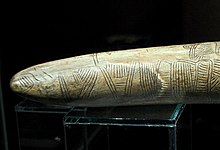
It is not always clear whether an ancient artifact had been wrought as a map or as something else. The definition of "map" is also not precise. Thus, no single artifact is generally accepted to be the earliest surviving map. Candidates include:
- A map-like representation of a mountain, river, valleys and routes around Pavlov in the Czech Republic, carved on a mammoth tusk, that has been dated to 25,000 BC.[1]
- An Aboriginal Australian cylcon that may be as much as 20,000 years old that is thought to depict the Darling River.[2]
- A map etched on a mammoth bone at Mezhyrich that is about 15,000 years old.
- Dots dating to 14,500 BC found on the walls of the Cuevas de El Castillo in Spain that contains a dot map of the Corona Borealis constellation dating from 12,000 BC.[3][4][5]
- A polished chunk of sandstone from a cave in Spanish Navarre, dated to 14,000 BC, that may be symbols for landscape features, such as hills or dwellings,[6] superimposed on animal etchings. Alternatively, it may also represent a spiritual landscape, or simple incisings.[7][8]
- Another ancient picture that resembles a map that was created in the late 7th millennium BC in Çatalhöyük, Anatolia, modern Turkey. This wall painting may represent a plan of this Neolithic village;[9] however, recent scholarship has questioned the identification of this painting as a map.[10]
- The "Saint-Bélec slab" (2200–1600 BC), whose lines and symbols have been argued to represent a cadastral plan of a part of western Brittany.[11]
Ancient Near East

Maps in Ancient
The
Phoenician sailors made major advances in seafaring and exploration. It is recorded that the first circumnavigation of Africa was possibly undertaken by Phoenician explorers employed by Egyptian pharaoh Necho II c. 610–595 BC.[15][16] In The Histories, written 431–425 BC, Herodotus cast doubt on a report of the Sun observed shining from the north. He stated that the phenomenon was observed by Phoenician explorers during their circumnavigation of Africa (The Histories, 4.42) who claimed to have had the Sun on their right when circumnavigating in a clockwise direction. To modern historians, these details confirm the truth of the Phoenicians' report, and even suggest the possibility that the Phoenicians knew about the spherical Earth model. However, nothing certain about their knowledge of geography and navigation has survived.[15] The historian Dmitri Panchenko theorizes that it was the Phoenician circumnavigation of Africa that inspired the theory of a spherical Earth by the 5th century BC.[16]
Ancient Greece
Many scholars throughout history, such as
Additional statements about ancient geography are found in
Early steps in the development of intellectual thought in
For constructing his world map, Anaximander is considered by many to be the first mapmaker.[22]: 23 Little is known about the map, which has not survived. Hecataeus of Miletus (550–475 BC) produced another map fifty years later that he claimed was an improved version of the map of his illustrious predecessor.
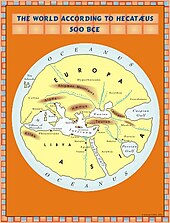
Hecatæus's map describes the Earth as disk with an encircling Ocean, and with Greece placed in the center. This was a very popular contemporary Greek worldview, derived originally from the Homeric poems. Also, similar to many other early maps in antiquity, his map has no scale. As units of measurements, this map used "days of sailing" on the sea and "days of marching" on dry land.[23] The purpose of this map was to accompany Hecatæus's geographical work that was called Periodos Ges, or Journey Round the World.[22]: 24 Periodos Ges was divided into two books, "Europe" and "Asia", with the latter including Libya, the name of which was an ancient term for all of known Africa.
The work divides the world into two continents, Asia and Europe. Hecatæus depicts the line between the Pillars of Hercules through the Bosporus, and the Don River as a boundary between the two. He was the first writer known to have thought that the Caspian flows into the encircling ocean—an idea that persisted long into the Hellenic period. He was particularly instructive about the Black Sea, adding many geographic places that already were known to Greeks through the colonization process. To the north of the Danube, according to Hecatæus, were the

Anaximenes of Miletus (6th century BC), who studied under Anaximander, rejected the views of his teacher regarding the shape of the Earth and instead, he visualized the Earth as a rectangular form supported by compressed air.
The way in which the geographical knowledge of the Greeks advanced from the previous assumptions of the Earth's shape was through Herodotus and his conceptual view of the world. This map also did not survive and many have speculated that it was never produced. A possible reconstruction of his map is displayed below.

Herodotus traveled extensively, collecting information and documenting his findings in his books on Europe, Asia, and Libya. He also combined his knowledge with what he learned from the people he met. Herodotus wrote his Histories in the mid-5th century BC. Although his work was dedicated to the story of long struggle of the Greeks with the Persian Empire, Herodotus also included everything he knew about the geography, history, and peoples of the world. Thus, his work provides a detailed picture of the known world of the 5th century BC.
Herodotus rejected the prevailing view of most 5th-century BC maps that the Earth is a disk surrounded by ocean. In his work he describes the Earth as an irregular shape with oceans surrounding only Asia and Africa. He introduces names such as the Atlantic Sea, and the
as the boundary between Asia and Africa. He speculated that the extent of Europe was much greater than was assumed at the time and left Europe's shape to be determined by future research.In the case of Africa, he believed that, except for the small stretch of land in the vicinity of Suez, the continent was in fact surrounded by water. However, he definitely disagreed with his predecessors and contemporaries about its presumed circular shape. He based his theory on the story of Pharaoh
Similar to his predecessors, Herodotus also made mistakes. He accepted a clear distinction between the civilized Greeks in the center of the Earth and the barbarians on the world's edges. In his Histories it is clear that he believed that the world became stranger and stranger when one traveled away from Greece, until one reached the ends of the Earth, where humans behaved as savages.
While various previous Greek philosophers presumed the Earth to be spherical, Aristotle (384–322 BC) is credited with proving the Earth's sphericity. His arguments may be summarized as follows:
- The lunar eclipse is always circular
- Ships seem to sink as they move away from view and pass the horizon
- Some stars can be seen only from certain parts of the Earth.
Hellenistic Mediterranean
A vital contribution to mapping the reality of the world came with a scientific estimate of the circumference of the earth. This event has been described as the first scientific attempt to give geographical studies a mathematical basis. The man credited for this achievement was
Roman Empire
Pomponius Mela
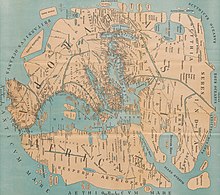
Pomponius Mela is unique among ancient geographers in that, after dividing the earth into five zones, of which two only were habitable, he asserts the existence of antichthones, inhabiting the southern temperate zone inaccessible to the folk of the northern temperate regions from the unbearable heat of the intervening torrid belt. On the divisions and boundaries of Europe, Asia and Africa, he repeats Eratosthenes; like all classical geographers from Alexander the Great (except Ptolemy) he regards the Caspian Sea as an inlet of the Northern Ocean, corresponding to the Persian Gulf and the Red Sea on the south.
Marinus of Tyre
Marinus's geographical treatise is lost and known only from Ptolemy's remarks. He introduced improvements to the construction of maps and developed a system of nautical charts. His chief legacy is that he first assigned to each place a proper
He also carefully studied the works of his predecessors and the diaries of travelers. His maps were the first in the
Ptolemy
Ptolemy's eight-volume atlas
Yet with all his important innovations, however, Ptolemy was not infallible. His most important error was a miscalculation of the circumference of the Earth. He believed that Eurasia covered 180° of the globe, which convinced Christopher Columbus to sail across the Atlantic to look for a simpler and faster way to travel to India. Had Columbus known that the true figure was much greater, it is conceivable that he would never have set out on his momentous voyage.
Tabula Peutingeriana
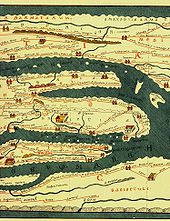
In 2007, the Tabula Peutingeriana, a 12th-century replica of a 5th-century road map, was placed on the UNESCO Memory of the World Register and displayed to the public for the first time. Although the scroll is well preserved and believed to be an accurate copy of an authentic original, it is on media that is now so delicate that it must be protected at all times from exposure to daylight.[37]
China
The earliest known maps to have survived in China date to the 4th century BC.[38]: 90 In 1986, seven ancient Chinese maps were found in an archeological excavation of a Qin State tomb in what is now Fangmatan, in the vicinity of Tianshui City, Gansu.[38]: 90 Before this find, the earliest extant maps that were known came from the Mawangdui Han tomb excavation in 1973, which found three maps on silk dated to the 2nd century BC in the early Han dynasty.[38]: 90, 93 The 4th-century BC maps from the State of Qin were drawn with black ink on wooden blocks.[38]: 91 These blocks fortunately survived in soaking conditions due to underground water that had seeped into the tomb; the quality of the wood had much to do with their survival.[38]: 91 After two years of slow-drying techniques, the maps were fully restored.[38]: 91
The territory shown in the seven Qin maps overlap each other.[38]: 92 The maps display tributary river systems of the Jialing River in Sichuan, in a total measured area of 107 by 68 km.[38]: 92 The maps featured rectangular symbols encasing character names for the locations of administrative counties.[38]: 92 Rivers and roads are displayed with similar line symbols; this makes interpreting the map somewhat difficult, although the labels of rivers placed in order of stream flow are helpful to modern day cartographers.[38]: 92–93 These maps also feature locations where different types of timber can be gathered, while two of the maps state the distances in mileage to the timber sites.[38]: 93 In light of this, these maps are perhaps the oldest economic maps in the world since they predate Strabo's economic maps.[38]: 93
In addition to the seven maps on wooden blocks found at Tomb 1 of Fangmatan, a fragment of a paper map was found on the chest of the occupant of Tomb 5 of Fangmatan in 1986. This tomb is dated to the early
Earliest geographical writing
In China, the earliest known geographical Chinese writing dates back to the 5th century BC, during the beginning of the
: 500Earliest known reference to a map (圖 tú)
The oldest reference to a map in China comes from the 3rd century BC.
Han dynasty
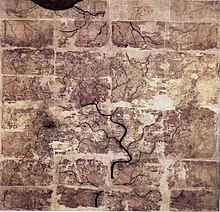
The three Han dynasty maps found at
An early text that mentioned maps was the Rites of Zhou.[41]: 534 Although attributed to the era of the Zhou dynasty, its first recorded appearance was in the libraries of Prince Liu De (c. 130 BC), and was compiled and commented on by Liu Xin in the 1st century AD. It outlined the use of maps that were made for governmental provinces and districts, principalities, frontier boundaries, and even pinpointed locations of ores and minerals for mining facilities.[41]: 534 Upon the investiture of three of his sons as feudal princes in 117 BC, Emperor Wu of Han had maps of the entire empire submitted to him.[41]: 536
From the 1st century AD onwards, official Chinese historical texts contained a geographical section (地理纪; Diliji), which was often an enormous compilation of changes in place-names and local administrative divisions controlled by the ruling dynasty, descriptions of mountain ranges, river systems, taxable products, etc.
Local mapmaking such as the one of
Pei Xiu, the 'Ptolemy of China'
In the year 267,
Later Chinese ideas about the quality of maps made during the Han dynasty and before stem from the assessment given by Pei Xiu.[38]: 96 Pei Xiu noted that the extant Han maps at his disposal were of little use since they featured too many inaccuracies and exaggerations in measured distance between locations.[38]: 96 However, the Qin State maps and Mawangdui maps of the Han era were far superior in quality than those examined by Pei Xiu.[38]: 96 It was not until the 20th century that Pei Xiu's 3rd-century assessment of earlier maps' dismal quality would be overturned and disproven. The Qin and Han maps did have a degree of accuracy in scale and pinpointed location, but the major improvement in Pei Xiu's work and that of his contemporaries was expressing topographical elevation on maps.[38]: 97
Sui dynasty
In the year 605, during the Sui dynasty (581–618), the Commercial Commissioner Pei Ju (547–627) created a famous geometrically gridded map.[41]: 543 In 610 Emperor Yang of Sui ordered government officials from throughout the empire to document in gazetteers the customs, products, and geographical features of their local areas and provinces, providing descriptive writing and drawing them all onto separate maps, which would be sent to the imperial secretariat in the capital city.[41]: 518 [44]: 409–10
Tang dynasty
The
Song dynasty
During the
Yuan Hsieh (d. +1220) was director-general of governmental grain stores. In pursuance of his schemes for the relief of famines he issued orders that each pao (village) should prepare a map which would show the fields and mountains, the rivers and the roads in fullest detail. The maps of all the pao were joined together to make a map of the tu (larger district), and these in turn were joined with others to make a map of the hsiang and the hsien (still larger districts). If there was any trouble about the collection of taxes or the distribution of grain, or if the question of chasing robbers and bandits arose, the provincial officials could readily carry out their duties by the aid of the maps.[41]: 518
Like the earlier Liang dynasty stone-stele maps (mentioned above), there were large and intricately carved stone stele maps of the Song period. For example, the 3 ft (0.91 m) squared stone stele map of an anonymous artist in 1137, following the grid scale of 100 li squared for each grid square.[41]: Plate LXXXI What is truly remarkable about this map is the incredibly precise detail of coastal outlines and river systems in China (refer to Needham's Volume 3, Plate LXXXI for an image). The map shows 500 settlements and a dozen rivers in China, and extends as far as Korea and India. On the reverse, a copy of a more ancient map uses grid coordinates in a scale of 1:1,500,000 and shows the coastline of China with great accuracy.[46]
The famous 11th-century scientist and polymath statesman Shen Kuo (1031–1095) was also a geographer and cartographer.[41]: 541 His largest atlas included twenty three maps of China and foreign regions that were drawn at a uniform scale of 1:900,000.[47] Shen also created a three-dimensional raised-relief map using sawdust, wood, beeswax, and wheat paste, while representing the topography and specific locations of a frontier region to the imperial court.[47] Shen Kuo's contemporary, Su Song (1020–1101), was a cartographer who created detailed maps to resolve a territorial border dispute between the Song dynasty and the Liao dynasty.[48]
Yuan dynasty (Mongol Empire)
In the
One of medieval Persian work written in northwest Iran can clarify the historical geography of Mongolia where Genghis Khan was born and united the Mongol and Turkic nomads as recorded in native sources, especially the Secret History of the Mongols.[54]
Map of relay stations, called "yam", and strategic points existed in the Yuan dynasty.[51] The Mongol cartography was enriched by traditions of ancient China and Iran which were now under the Mongols.
Because the Yuan court often requested the western Mongol khanates to send their maps, the Yuan dynasty was able to publish a map describing the whole Mongol world in c.1330. This is called "Hsi-pei pi ti-li tu". The map includes the Mongol dominions including 30 cities in Iran such as
Ming dynasty
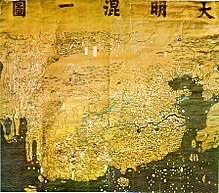
The multicolour map,
In 1579, Luo Hongxian published the Guang Yutu atlas, including more than 40 maps, a grid system, and a systematic way of representing major landmarks such as mountains, rivers, roads and borders. The Guang Yutu incorporates the discoveries of the naval explorer Zheng He's 15th-century voyages along the coasts of China, Southeast Asia, India and Africa.[46]
Qing dynasty
From the 16th and 17th centuries, several examples survive of maps focused on cultural information. Gridlines are not used on either
Japan and Korea

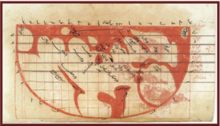
In 1402, Yi Hoe and Kwan Yun created a world map largely based from Chinese cartographers called the Gangnido map. It is currently one of the oldest surviving world maps from East Asia.[64] Another notable pre-modern map is the Cheonhado map developed in Korea in the 17th century.[65]
Sekisui Nagakubo produced a world map in 1785 called the Comprehensive Map and Description of the Geography of the Myriad Countries of the Globe (地球萬國山海輿地全圖說), mainly deriving it from an earlier map made by Matteo Ricci. The production was made by woodblock print and folded into paper boards, he made corrections and additions on top of Matteo's production. This was one of the earliest maps with longitude and latitude information in Japan and was written in Katakana.[66]
Another well-known cartographer of the late-Edo period was Ino Tadataka, he is known for completing the first map of Japan using modern surveying techniques.[67] His most famous work, the Dai Nihon Enkai Yochi Zenzu (大日本沿海輿地全図) consisted of three large map pages at a scale of 1:432,000 and it showed the entire country on eight pages at 1:216,000. Some of his maps are accurate to 1/1000 of a degree, which allowed it to become the definitive maps used in Japan for nearly a century. Maps based on his work were in use as late as 1924.
India
Ancient India
Indian cartographic traditions covered the locations of the Pole star and other constellations of use.[68]: 330 These charts may have been in use by the beginning of the Common Era for purposes of navigation.[68]: 330
Detailed maps of considerable length describing the locations of settlements, sea shores, rivers, and mountains were also made.[68]: 327 The 8th-century scholar Bhavabhuti conceived paintings which indicated geographical regions.[68]: 328
Italian scholar Francesco Lorenzo Pullè reproduced a number of ancient Indian maps in his magnum opus La Cartografia Antica dell'India.
Mughal era
Maps from the
The scholar Sadiq Isfahani of Jaunpur compiled an atlas of the parts of the world which he held to be 'suitable for human life'.[69] The 32 sheet atlas—with maps oriented towards the south as was the case with Islamic works of the era—is part of a larger scholarly work compiled by Isfahani during 1647 CE.[69] According to Joseph E. Schwartzberg (2008): 'The largest known Indian map, depicting the former Rajput capital at Amber in remarkable house-by-house detail, measures 661 × 645 cm.[70] (260 × 254 in., or approximately 22 × 21 ft).'[70]
Islamic cartographic schools
Arab and Persian cartography
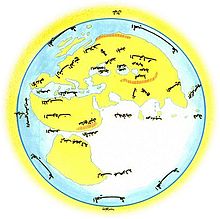
In the Middle Ages, Muslim scholars continued and advanced on the mapmaking traditions of earlier cultures. Most used Ptolemy's methods; but they also took advantage of what explorers and merchants learned in their travels across the Muslim world, from Spain to India to Africa, and beyond in trade relationships with China, and Russia.[26]
An important influence in the development of
Also in the 9th century, the
In the early 10th century,
Suhrāb, a late 10th-century Muslim geographer, accompanied a book of geographical
Ibn Battuta (1304–1368?) wrote "Rihlah" (Travels) based on three decades of journeys, covering more than 120,000 km through northern Africa, southern Europe, and much of Asia.
Islamic regional cartography
Islamic regional cartography is usually categorized into three groups: that produced by the "
The maps by the Balkhī schools were defined by political, not longitudinal boundaries and covered only the Muslim world. In these maps the distances between various "stops" (cities or rivers) were equalized. The only shapes used in designs were verticals, horizontals, 90-degree angles, and arcs of circles; unnecessary geographical details were eliminated. This approach is similar to that used in
Al-Idrīsī defined his maps differently. He considered the extent of the known world to be 160° in longitude, and divided the region into ten parts, each 16° wide. In terms of latitude, he portioned the known world into seven 'climes', determined by the length of the longest day. In his maps, many dominant geographical features can be found.[71]
Book on the appearance of the Earth
Al-Khwārizmī,
Al-Biruni
Around 1025, Al-Biruni was the first to describe a polar equi-azimuthal equidistant projection of the celestial sphere.[82]
In his Codex Masudicus (1037), Al-Biruni theorized the existence of a landmass along the vast ocean between Asia and Europe, or what is today known as the Americas. He deduced its existence on the basis of his accurate estimations of the
Tabula Rogeriana

The
On the work of al-Idrisi, S. P. Scott commented:[85]
The compilation of Edrisi marks an era in the history of science. Not only is its historical information most interesting and valuable, but its descriptions of many parts of the earth are still authoritative. For three centuries geographers copied his maps without alteration. The relative position of the lakes which form the Nile, as delineated in his work, does not differ greatly from that established by Baker and Stanley more than seven hundred years afterwards, and their number is the same. The mechanical genius of the author was not inferior to his erudition. The celestial and terrestrial planisphere of silver which he constructed for his royal patron was nearly six feet in diameter, and weighed four hundred and fifty pounds; upon the one side the zodiac and the constellations, upon the other—divided for convenience into segments—the bodies of land and water, with the respective situations of the various countries, were engraved.
— S. P. Scott, History of the Moorish Empire in Europe
Al-Idrisi's atlas, originally called the Nuzhat in Arabic, served as a major tool for Italian, Dutch and French mapmakers from the 16th century to the 18th century.[86]
Piri Reis map of the Ottoman Empire
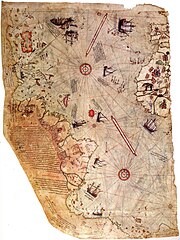
The Ottoman cartographer Piri Reis published navigational maps in his Kitab-ı Bahriye. The work includes an atlas of charts for small segments of the mediterranean, accompanied by sailing instructions covering the sea. In the second version of the work, he included a map of the Americas.[71]: 106 The Piri Reis map drawn by the Ottoman cartographer Piri Reis in 1513, is one of the oldest surviving maps to show the Americas.[87]: 268–272 [88][89][90]
Medieval Europe

Medieval maps and the Mappa Mundi
Medieval maps of the world in Europe were mainly symbolic in form along the lines of the much earlier

Italian cartography and the birth of portolan charts
Majorcan cartographic school and the "normal" portolan chart
The
Polynesian stick charts
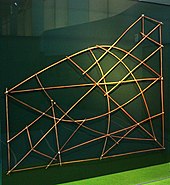
The
Modern era
Iberian cartography in the Age of Exploration
In the
During the 15th and 16th centuries, Iberian powers (

In 1492, when a Spanish expedition headed by
The
- c. 1485: Portuguese cartographer Pedro Reinel made the oldest known signed Portuguese nautical chart.
- 1492: Cartographer Jorge de Aguiar made the oldest known signed and dated Portuguese nautical chart.
- 1537: Much of Portuguese mathematician and cosmographer Mercator Projectionis the system which is still used.
First maps of the Americas
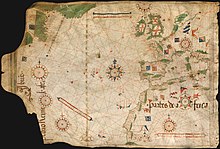
- 1500: The Spanish cartographer and explorer Juan de la Cosa created the first known cartographic representations showing both the Americas as well as Africa and Eurasia.
- 1502: Unknown Portuguese cartographer made the Cantino planisphere, the first nautical chart to implicitly represent latitudes.
- 1504: Portuguese cartographer Pedro Reinel made the oldest known nautical chart with a scale of latitudes.
- 1519 : Portuguese cartographers Lopo Homem, Pedro Reinel and Jorge Reinel made the group of maps known today as the Miller Atlas or Lopo Homem – Reinéis Atlas.
- 1530: Alonzo de Santa Cruz, Spanish cartographer, produced the first map of magnetic variations from true north. He believed it would be of use in finding the correct longitude. Santa Cruz also designed new nautical instruments,[98] and was interested in navigational methods.
Padrón Real of the Spanish Empire
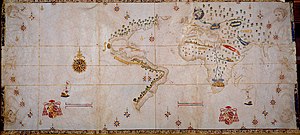
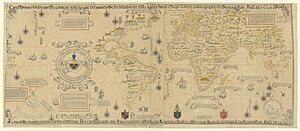
Founded 1504 in Seville, the Spanish House of Trade (Casa de Contratación) kept a large contingent of cartographers as Spain's overseas empire expanded. A royal standard map (Padrón Real) was established in 1508 and updated periodically as more information became available from major expeditions returning to Seville.[99][100][101] This continued a practice of long standing in Portugal, whose Padrão Real was kept in the Guinea and India Houses (Casa da Guiné and da Índia) within the royal palace in Lisbon.
The originals of the Spanish and Portuguese maps are now lost but copies of known provenance are held by the
Two prominent cosmographers (as mapmakers were then known) of the House of Trade were
German cartography
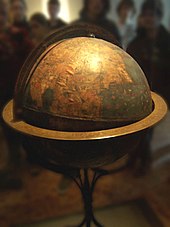
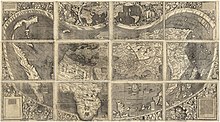
- 15th century: The German monk Nicolaus Germanus wrote a pioneering Cosmographia. He added the first new maps to Ptolemy's Geographica.[6] Germanus invented the Donis map projection where parallels of latitude are made equidistant, but meridians converge toward the poles.
- 1492: German merchant Martin Behaim (1459–1507) made the oldest surviving terrestrial globe, but it lacked the Americas.[6]
- 1507: German cartographer Martin Waldseemüller's world map (Waldseemüller map) was the first to use the term America for the Western continents (after explorer Amerigo Vespucci).[6]
- 1603: German star atlas (Uranometria) was published in Augsburg in 1603 and was the first atlas to cover the entire celestial sphere.
Dutch and Flemish cartography

Gerardus Mercator, the German-Netherlandish cartographer and geographer with a vast output of wall maps, bound maps, globes and scientific instruments but his greatest legacy was the
Mercator spent the last thirty years of his life working on a vast project, the Cosmographia;[b] a description of the whole universe including the creation and a description of the topography, history and institutions of all countries. The word atlas makes its first appearance in the title of the final volume: "Atlas sive cosmographicae meditationes de fabrica mundi et fabricati figura". This translates as Atlas OR cosmographical meditations upon the creation of the universe, and the universe as created, thus providing Mercator's definition of the term atlas. These volumes devote slightly less than one half of their pages to maps: Mercator did not use the term solely to describe a bound collection of maps. His choice of title was motivated by his respect for Atlas "King of Mauretania"[105]
Abraham Ortelius is generally recognized as the creator of the first modern atlas, the
The modern systematic use of
The first printed atlas of nautical charts (De Spieghel der Zeevaerdt or The Mirror of Navigation / The Mariner's Mirror) was produced by Lucas Waghenaer in Leiden in 1584. This atlas was the first attempt to systematically codify nautical maps. This chart-book combined an atlas of nautical charts and sailing directions with instructions for navigation on the western and north-western coastal waters of Europe. It was the first of its kind in the history of maritime cartography.[113][114][115][116]
In 1660, the German-born Dutch cartographer
In the long run the competition between map-making firms Blaeu and Janssonius resulted in the publication of an Atlas Maior or 'Major Atlas'. In 1662 the Latin edition of Joan Blaeu's Atlas Maior appeared in eleven volumes and with approximately 600 maps. In the years to come French and Dutch editions followed in twelve and nine volumes respectively. Purely judging from the number of maps in the Atlas Maior, Blaeu had outdone his rival Jan Janssonius. And also from a commercial point of view it was a huge success. Also due to the superior typography the Atlas Maior by Blaeu soon became a status symbol for rich citizens. Costing 350 guilders for a non-coloured and 450 guilders for a coloured version, the atlas was the most precious book of the 17th century. However, the Atlas Maior was also a turning point: after that time the role of Dutch cartography (and Netherlandish cartography in general) was finished. Janssonius died in 1664 while a great fire in 1672 destroyed one of Blaeu's print shops. In that fire a part of the copperplates went up in flames. Fairly soon afterwards Joan Blaeu died, in 1673. The almost 2,000 copperplates of Janssonius and Blaeu found their way to other publishers.
French cartography
Historian David Buisseret has traced the roots of the flourishing of cartography in the 16th and 17th centuries in Europe. He noted five distinct reasons: 1) admiration of antiquity, especially the rediscovery of Ptolemy, considered to be the first geographer; 2) increasing reliance on measurement and quantification as a result of the scientific revolution; 3) refinements in the visual arts, such as the discovery of perspective, that allowed for better representation of spatial entities; 4) development of estate property; and 5) the importance of mapping to nation-building.[117]
The reign of Louis XIV is generally considered to represent the beginning of cartography as a science in France.[118]: 42 The evolution of cartography during the transition between the 17th and 18th centuries involved advancements on a technical level, as well as those on a representative level. According to Marco Petrella, the map developed "from a tool used to affirm the administrative borders of the reign and its features…into a tool which was necessary to intervene in territory and thus establish control of it."[119][page needed] Because unification of the kingdom necessitated well-kept records of land and tax bases, Louis XIV and members of the royal court pushed the development and progression of the sciences, especially cartography. Louis XIV established the Académie des Sciences in 1666, with the expressed purpose of improving cartography and sailing charts. It was found that all the gaps of knowledge in geography and navigation could be accounted for in the further exploration and study of astronomy and geodesy.[120][page needed] Colbert also attracted many foreign scientists to the Académie des Sciences to support the pursuit of scientific knowledge.[118]: 45
Under the auspices of the Sun King and Jean-Baptiste Colbert, members of the Académie des Sciences made many breakthrough discoveries within the realm of cartography to ensure accuracy of their works. Among the more prominent work done with the Académie was that done by
Jean-Baptiste Colbert, the secretary of home affairs and prominent member of Louis XIV's royal court, set out to develop the resource base of the nation and to develop a system of infrastructure that could restore the French economy. He wanted to generate income for the high expenses incurred by Louis XIV. What Colbert lacked in his pursuit of the development of the economy was a map of the entire country. France, like all other countries of Europe, operated on local knowledge. Within France, there were local systems of measuring weight and taxes; a uniform notion of land surveying did not exist.[120]: 16 The advancements made by the members of the Académie des Sciences proved instrumental as a tool to aid reform within the nation. Cartography was an important element in two major reforms undertaken by Colbert: the reform of the royal forest, a project undertaken beginning in 1661, and naval reform, initiated in 1664.[118]: 44
In 1663–1664 Colbert tried to collect information from the provinces to accurately assess the income within the kingdom, necessary information for economic and tax reform. Colbert asked the provincial representatives of the king, the intendants, to gather existing maps of territory within the provinces and check them for accuracy. If they were found not to be accurate, the Royal Geographer, Nicolas Sanson, was to edit them, basing his information on the reports prepared by the intendants. The operation did not succeed because the Académie des Sciences did not believe it had a strong enough basis in cartographic methodology.[118]: 45 The importance of cartography to the mechanisms of the state, however, continued to grow.
In the 1670s the astronomer
Paris as the center of cartography
The seventeenth century marked the emergence of France as the center of the map trade in Europe, with much of the production and distribution of maps taking place in the capital Paris.[124]: 33–45 In conjunction with the support of scientific development, the royal court encouraged the work of arts and artisans. This royal patronage attracted artists to Paris. As a result, many mapmakers, such as Nicolas Sanson and Alexis-Hubert Jaillot, moved to the national capital from the peripheries of the provinces.[124]: 34
Many of the agents of cartography, including those involved in the creation, production and distribution of maps in Paris, came to live in the same section of the capital city. Booksellers congregated on rue St-Jacques along the left bank of the Seine, while engravers and cartographers lived along the quai de l'Horloge on the Île de la Cité (See Figure 1). Regulations enacted by the communautés informed the location of the libraries. These regulations included that each bookseller-printer was to have one shop, which had to be located in the university quarter or on the quai de l'Horloge. These restrictions enabled authorities to more easily inspect their businesses to enforce other regulations such as: printer need to register the number of presses they owned, and any books printed had to be registered and approved by the royal court before sales.[124]: 34 Opticians were also located ton he Quai de l'Horloge. Their tools – squares, rules, compasses and dividers – were essential to the practice of cartography.[124]: 37
Many of the cartographers who worked in Paris never set foot outside the city; they did not gather firsthand knowledge for their maps. They were known as the geographes de cabinet. An example of a cartographer who relied on other sources was Jean-Baptiste Bourgignon d'Anville, who compiled his information from ancient and modern sources, verbal and pictorial, published and even unpublished sources.[124]: 39
Dieppe school of cartographers
The
.18th-century developments

The Vertical Perspective projection was first used by the German map publisher
The changes in the use of military maps was also part of the modern Military Revolution, which changed the need for information as the scale of conflict increases as well. This created a need for maps to help with "... consistency, regularity and uniformity in military conflict."[125]
The final form of the equidistant conic projection was constructed by the French astronomer Joseph-Nicolas Delisle in 1745.[76]
The Swiss mathematician
The
In 1715 Herman Moll published the Beaver Map, one of the most famous early maps of North America, which he copied from a 1698 work by Nicolas de Fer.
In 1763–1767 Captain James Cook mapped Newfoundland.
In 1777 Colonel Joseph Frederick Wallet DesBarres created a monumental four volume atlas of North America, Atlantic Neptune.

In the United States in the 18th and 19th centuries, explorers mapped trails and
19th-century developments

During his travels in Spanish America (1799–1804) Alexander von Humboldt created the most accurate map of New Spain (now Mexico) to date. Published as part of his Essai politique sur le royaume de la Nouvelle-Espagne (1811) (Political Essay on the Kingdom of New Spain), Humboldt's Carte du Mexique (1804) was based on existing maps of Mexico, but with Humboldt's careful attention to latitude and longitude. Landing at the Pacific coast port of Acapulco in 1803, Humboldt did not leave the port area for Mexico City until he produced a map of the port; when leaving he drew a map of the east coast port of Veracruz, as well as a map of the central plateau of Mexico. Given royal authorization from the Spanish crown for his trip, crown officials in Mexico were eager to aid Humboldt's research. He had access to José Antonio de Alzate y Ramírez's Mapa del Arzobispado de México (1768), which he deemed "very bad", as well as the seventeenth-century map of greater Mexico City by savant Don Carlos de Sigüenza y Góngora.[127]
John Disturnell, a businessman and publisher of guidebooks and maps, published Mapa de los Estados Unidos de Méjico, which was used in the negotiations between the U.S. and Mexico in the
The Greenwich prime meridian became the international standard reference for cartographers in 1884.
20th-century developments
During the 20th century, maps became more abundant due to improvements in printing and photography that made production cheaper and easier. Airplanes made it possible to photograph large areas at a time.
Two-point equidistant projection was first drawn up by Hans Maurer in 1919. In this projection the distance from any point on the map to either of the two regulating points is accurate.[76]
The
Since the mid-1990s, the use of computers in map making has helped to store, sort, and arrange data for mapping to create map projections.[130]
Contemporary developments
Software development
Nowadays map-making heavily relies on computer software to develop and provide a variety of services, a trend that already started at the end of the previous century. For instance, self-location, browser search of places, business, products, and area, and distance calculation. At the present time, computer-based software is dominated by big companies that offer their services to a worldwide public, such as
Historical map collections
Recent development also include the integration of ancient maps and modern scholar research combined with modern computer software to elaborate periodical history maps. Initiatives such as
Today historical cartography is thriving. The specialization of map services is ever growing. New map projections are still being developed, university map collections, such as Perry–Castañeda Library Map Collection at the University of Texas, offer better and more diverse maps and map tools every day, making available for their students and the broad public ancient maps that in the past were difficult to find. David Rumsey Historical Map Collection is nowadays a worldwide known initiative.
Self-publishing tools and collaborative mapping
Never in the past there were many "edit-yourself" map tools and software available for non-specialist. Map blogs and self-publishing are common.[citation needed] In 2004, Steve Coast created OpenStreetMap, a collaborative project to create a free editable map of the world. The creation and growth of OpenStreetMap has been motivated by restrictions on use or availability of map information across much of the world, and the advent of inexpensive portable satellite navigation devices.[131][132]
Organizations
In 1921, the International Hydrographic Organization (IHO) was set up, and it constitutes the authority on hydrographic surveying and nautical charting.[133] The current defining document is the Special publication S-23, Limits of Oceans and Seas, 3rd edition, 1953. The second edition dated back to 1937, and the first to 1928. A fourth edition draft was published in 1986 but so far several naming disputes (such as the one over the Sea of Japan) have prevented its ratification.
History of cartography's technological changes

In cartography, technology has continually changed to meet the demands of new generations of mapmakers and map users. The first maps were manually constructed with brushes and parchment and therefore varied in quality and were limited in distribution. The advent of the compass, printing press, telescope, sextant, quadrant and vernier allowed for the creation of far more accurate maps and the ability to make accurate reproductions. Professor Steven Weber of the University of California, Berkeley, has advanced the hypothesis that the concept of the "nation state" is an inadvertent byproduct of 15th-century advances in map-making technologies.[96][97]
Advances in photochemical technology, such as the lithographic and photochemical processes, have allowed for the creation of maps that have fine details, do not distort in shape and resist moisture and wear. This also eliminated the need for engraving which further shortened the time it takes to make and reproduce maps.
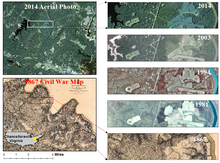
In the mid-to-late 20th century, advances in electronic technology have led to further revolution in cartography. Specifically computer hardware devices such as computer screens, plotters, printers, scanners (remote and document) and analytic stereo plotters along with visualization, image processing, spatial analysis and database software, have democratized and greatly expanded the making of maps, particularly with their ability to produce maps that show slightly different features, without engraving a new printing plate. See also digital raster graphic and History of web mapping.
Aerial photography and satellite imagery have provided high-accuracy, high-throughput methods for mapping physical features over large areas, such as coastlines, roads, buildings, and topography.[134]
See also
- City map – large-scale thematic map of a citys
- Early world maps – List of early depictions of the world
- Forma Urbis Romae – Marble map of ancient Rome (c.205-208)
- Geographic information system – System to capture, manage and present geographic data
- Great Trigonometrical Survey – 19th-century survey to measure the Indian subcontinent (India)
- Here be dragons – Phrase used on maps to indicate uncharted areas
- History of Cartography Project – Publishing project in the Department of Geography at the University of Wisconsin–Madison
- Early modern Iberian (Spanish and Portuguese) cartography
- Early modern Netherlandish (Dutch and Flemish) cartography
- Cartography of India – Overview of the cartography of India
- List of cartographers
- List of historical maps
- Map projection – Systematic representation of the surface of a sphere or ellipsoid onto a plane
- Mappa mundi – Medieval European maps of the world
- Pictorial maps– Map that uses pictures to represent features
- Principal Triangulation of Great Britain – 1791–1853 geodetic survey of Britain
- Terra incognita – "Unknown land", area not mapped by cartographers
- The Royal Thai Survey Department – military unit
- Web mapping – Process of using the maps delivered by geographic information systems (GIS) in World Wide Web
- World map – Map of most or all of the surface of the Earth
Related histories
- History of geography
- History of geodesy
- History of navigation – Intersection of history and navigation
- History of surveying– Science of determining the positions of points and the distances and angles between them
- History of cadastre– Comprehensive register of the real estate or real property's metes-and-bounds of a country
- History of topographic mapping– Medium to large scale map that shows a precise map of the terrain
Notes
- ^ For a value of a 185 m or 607 ft per stadion.
- ^ See the discussion in Gerardus Mercator#Duisburg 1552–1594
Citations
- ISSN 1790-3769. Retrieved 24 January 2015.
- ^ Schøyen Collection, MS 5087/36, Cylcon (Yurda), possibly with map of Darling River Archived 24 April 2022 at the Wayback Machine, commentary.
- ^ "Ice Age star map discovered". BBC News. 9 August 2000.
- ^ "Astronomical Artefacts and Cuneiform Tablets, etc". Web Site For Gary D. Thompson, West Melton, Australia. Archived from the original on 30 January 2007. Retrieved 15 May 2008.
- ^ "Published scientific papers – MR". Institute for Interdisciplinary Studies. Archived from the original on 28 August 2008. Retrieved 15 May 2008.
- ^ a b c d e f Frenz, Thomas. "Tutorials in the History of Cartography – Overview". Archived from the original on 6 July 2006.
- .
- PMID 19625071.
- ^ "henrydavis.com – Ancient Images". Henry Davis Consulting.
- ^ Meece, Stephanie (2006). "A bird's eye view – of a leopard's spots. The Çatalhöyük 'map' and the development of cartographic representation in prehistory". DSpace @ Cambridge.
- ^ Clement Nicolas, Yvan Pailler, Pierre Stéphan, Julie Pierson, Laurent Aubry, et al.. La carte et le territoire : la dalle gravée du Bronze ancien de Saint-Bélec (Leuhan, Finistère). Bulletin de la Société préhistorique française, Société préhistorique française, 2021, 118 (1), pp.99–146. Online at https://www.prehistoire.org/shop_515-47906-5446-800/04-2021-tome-118-1-p.-99-146-c.-nicolas-y.-pailler-p.-stephan-j.-pierson-l.-aubry-b.-le-gall-b.-le-gall-v.-lacombe-j.-rolet-la-carte-et-le-territoire-la-dalle-gravee-du-bronze-ancien-de-saint-belec-leuhan-finistere.html
- ^ "The History of Cartography Book Series". Archived from the original on 16 July 2006.
- ^ "Slide #100: The Earliest Known Map". Henry Davis Consulting. Archived from the original on 20 August 2007. Retrieved 20 June 2006.
- ^ "Ancient map of Nippur, Kassite period". The Nippur Expedition. Oriental Institute, University of Chicago. Archived from the original on 5 September 2008. Retrieved 20 June 2006.
- ^ a b Friis, Herman Ralph (1967). The Pacific Basin: A History of Its Geographical Exploration. American Geographical Society. p. 19.
- ^ ISBN 9788447211562.
- ^ a b Brown[full citation needed]
- ^ Thompson, 21
- ^ Kirsh, 1[full citation needed]
- ^ Keane, 6–7[full citation needed]
- ^ "henry-davis-image". Henry Davis Consulting. Archived from the original on 10 September 2009. Retrieved 20 June 2006.
- ^ a b Dilke[full citation needed]
- ^ Goode, 2[full citation needed]
- ^ Tozer, 63[full citation needed]
- S2CID 129758198.
- ^ a b c "Slide #219: World Maps of al-Idrisi". Henry Davis Consulting. Archived from the original on 26 June 2006. Retrieved 20 June 2006.
- ^ Noble, 27[full citation needed]
- ^ Russo, Lucio (2004). The Forgotten Revolution. Berlin: Springer. p. 273–277.
- ^ "henry davis-ancient images". Henry Davis Consulting. Archived from the original on 10 September 2009. Retrieved 20 June 2006.
- ISBN 978-0-521-34896-6.
- ISBN 978-1-4008-3221-7.
- ^ "Notes on Ancient Times in Malaya" Roland Braddell. Journal of the Malayan Branch of the Royal Asiatic Society, Vol. 23, No. 3 (153) 1947 (1950), p. 9
- ISBN 0-321-01618-1
{{cite book}}: CS1 maint: location missing publisher (link)[publisher missing]
References
- R. A. Skelton. Transaction Publishers.
- Crawford, P. V. (1973). "The perception of graduated squares as cartographic symbols". The Cartographic Journal. 10 (2): 85–88. .
- Edney, Matthew H.; Pedley, Mary S. (eds.). "Cartography in the European Enlightenment". The History of Cartography. Vol. 4. Chicago and London: University of Chicago Press.
- ESRI (2004). ESRI Cartography: Capabilities and Trends. Redlands.
{{cite book}}: CS1 maint: location missing publisher (link) - ISBN 978-0-226-31633-8.
- Harley, J. B.; Woodward, David, eds. (1987). "Cartography in the Traditional Islamic and South Asian Societies". The History of Cartography. Vol. II-1. Chicago and London: University of Chicago Press. ISBN 978-0-226-31635-2.
- Harley, J. B.; Woodward, David, eds. (1987). "Cartography in the Traditional East and Southeast Asian Societies". The History of Cartography. Vol. II-2. Chicago and London: University of Chicago Press. ISBN 978-0-226-31637-6.
- Harley, J. B.; Woodward, David, eds. (1987). "Cartography in the Traditional African, American, Arctic, Australian, and Pacific Societies". The History of Cartography. Vol. II-3. Chicago and London: University of Chicago Press. ISBN 978-0-226-90728-4.
- "Harvard Graduate School of Design". 2005. Archived from the original on 16 June 2006.
- Imus, D.; Dunlavey, P (2002). Back to the Drawing Board: Cartography vs the Digital Workflow. Hood, Oregon: MT.
- Jeer, S. (1997). Traditional Color Coding for Land Uses. American Planning Association. pp. 4–5.
- Kain, Roger J. P (ed.). "Cartography in the 19th century". The History of Cartography. Vol. 5. Chicago and London: University of Chicago Press.
- MacEachren, A.M. (1994). Some Truth with Maps: A Primer on Symbolization & Design. University Park: The Pennsylvania State University.
- MacEachren, A.M. (1995). How Maps Work. New York: The Guilford Press.
- "Map Imitations". Library and Archives Canada. Archived from the original on 22 March 2016. Retrieved 25 April 2007.
- Monmonier, Mark (1991). How to Lie with Maps. Chicago: University of Chicago Press. ISBN 978-0-226-53421-3.
- Monmonier, Mark (1993). Mapping It Out. Chicago: University of Chicago Press.
- Monmonier, Mark, ed. (2015). "Cartography in the Twentieth Century". The History of Cartography. Vol. 6. Chicago and London: University of Chicago Press. ISBN 978-0-226-53469-5.
- Olson, Judy M. (1975). "Experience and the improvement of cartographic communication". The Cartographic Journal. 12 (2): 94–108. .
- Phillips, R.; De Lucia, A.; Skelton, A. (1975). "Some Objective Tests of the Legibility of Relief Maps". The Cartographic Journal. 12 (1): 39–46. .
- Phillips, R.; Noyes, L. (1980). "A Comparison of Color and Visual Texture as Codes for use as Area Symbols on Relief Maps". Ergonomics. 23 (12): 1117–28. PMID 28080606.
- Pickles, John (2003). A History of Spaces: Cartographic Reason, Mapping, and the Geo-Coded World. Taylor & Francis. ISBN 978-0-415-14497-1.
- Rice, M.; Jacobson, R.; Golledge, R.; Jones, D.; Pallavaram, S. (2003). "Object Size Discrimination and Non-visual Cartographic Symbolization". Proceedings, American Congress on Surveying and Mapping (ACSM) Annual Conference. 29: 1–12.
- Robinson, A.H. (1953). Elements of Cartography. New York: John Wiley & Sons.
- Robinson, Arthur H. (1982). Early Thematic Mapping in the History of Cartography. Chicago: The University of Chicago Press.
- Slocum, T. (1999). Thematic Cartography and Geographic Visualization. Upper Saddle River, New Jersey: Prentice Hall.
- Singaravélou, P.; Argounès, F. (2021). Mapping the World. Perspectives from Asian Cartography. Singapore: National Library of Singapore.
- Sullivan, David (2000), A translation of the full text of the Mercator atlas of 1595 (PDF), archived from the original (PDF) on 10 March 2016
- Wilford, John Noble (2000). The Mapmakers. Vintage Books. ISBN 978-0-375-70850-3.
- Woodward, David, ed. (1987). "Cartography in the European Renaissance". The History of Cartography. Vol. 3. Chicago and London: University of Chicago Press. ISBN 978-0-226-90733-8.
- "A Mathematical Method for Visualizing Ptolemy's India in Modern GIS Tools".
External links
- Imago Mundi journal of History of Cartography
- The History of Cartography journal published by the University of Chicago Press
- Euratlas Historical Maps History maps from year zero AD
- The History of Cartography Project at the University of Wisconsin, a comprehensive research project in the history of maps and mapping
- Three volumes of The History of Cartography are available free in PDF format
- The history of cartography at the School of Mathematics and Statistics, University of St. Andrews, Scotland
- Mapping History – a learning resource from the British Library
- Modern Medieval Map Myths: The Flat World, Ancient Sea-Kings, and Dragons
- Concise Bibliography of the History of Cartography Archived 26 October 2011 at the Wayback Machine, Newberry Library
- Newberry Library Cartographic Catalog : map catalog and bibliography of the history of cartography
- American Geographical Society Library Digital Map Collection
- David Rumsey Historical map collection licensed under a Creative Commons License
See
- Eratosthenes Map of the Earth, and Measuring of its Circumference at Convergence
- Ancient World Maps
- A listing of over 5000 websites describing holdings of manuscripts, archives, rare books, historical photographs, and other primary sources for the research scholar
- Historical Atlas in Persuasive Cartography, The PJ Mode Collection, Cornell University Library
- Old Maps Online

